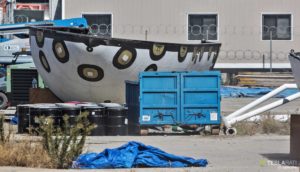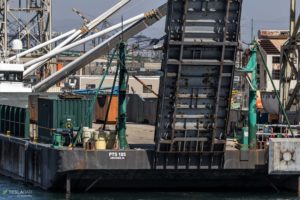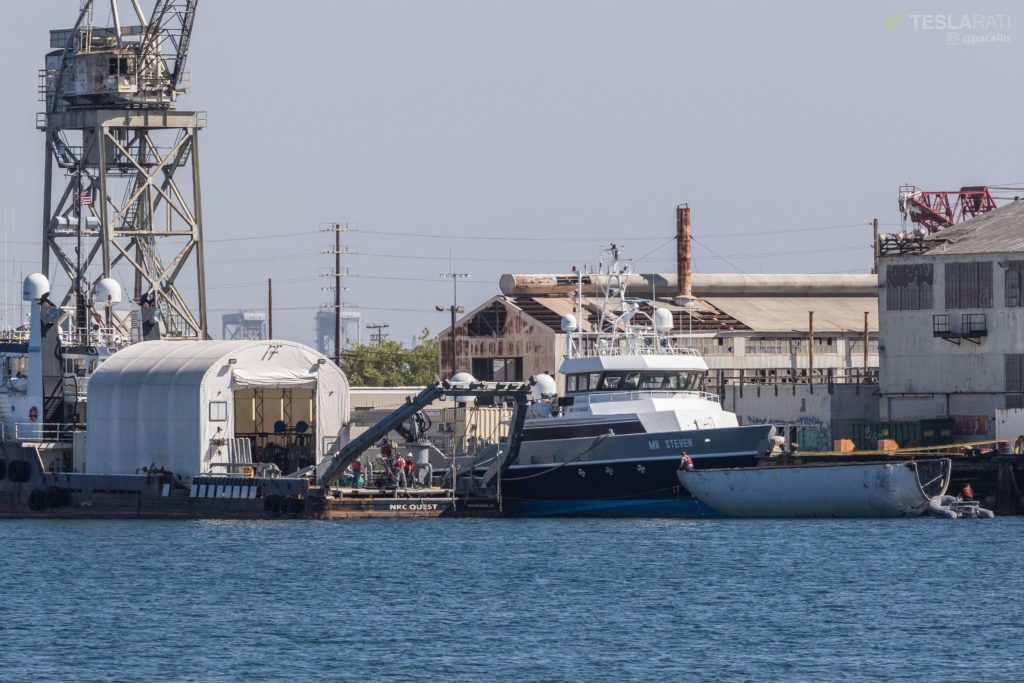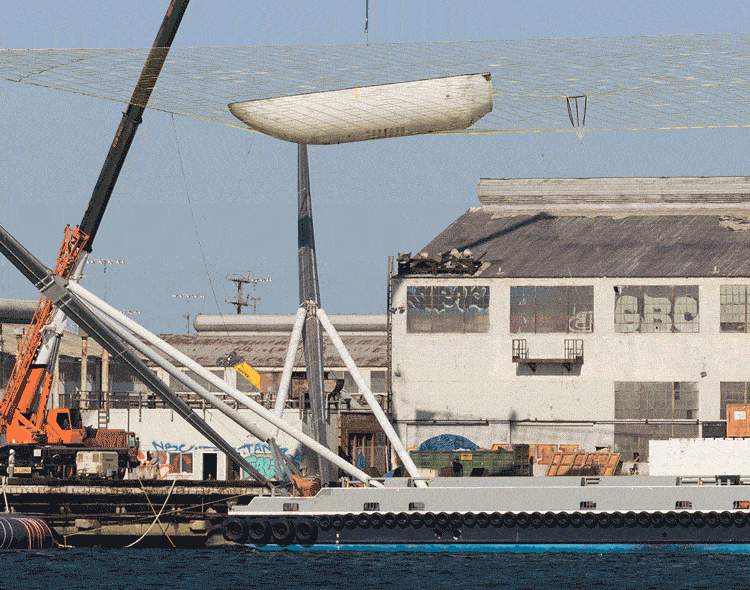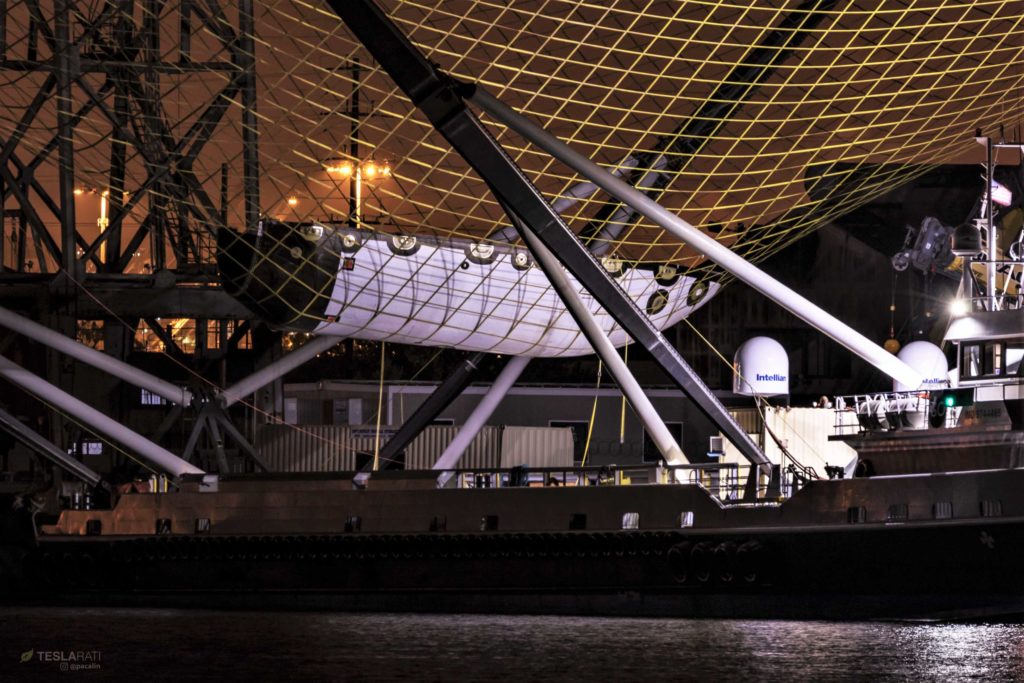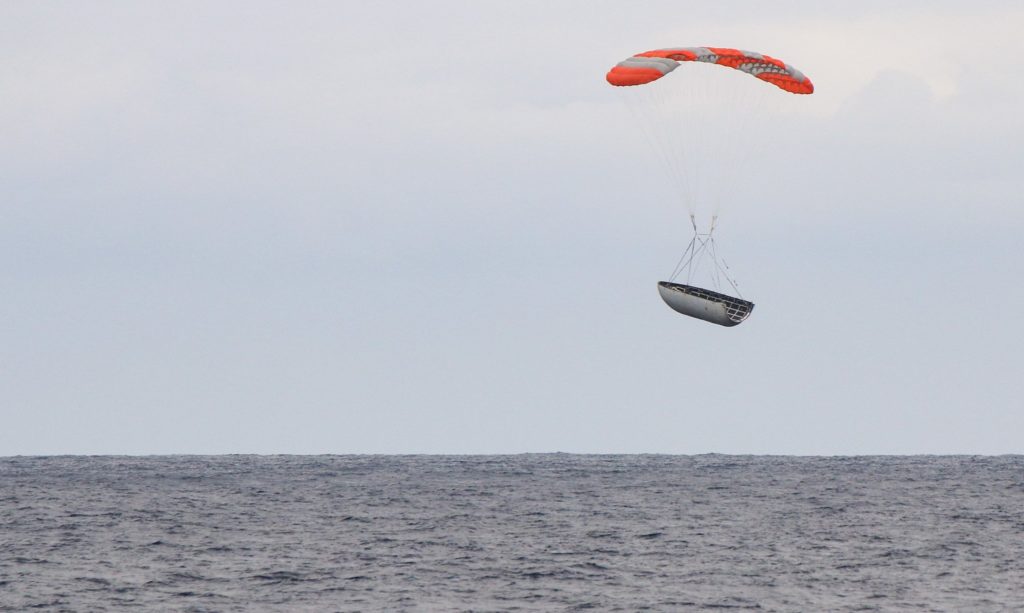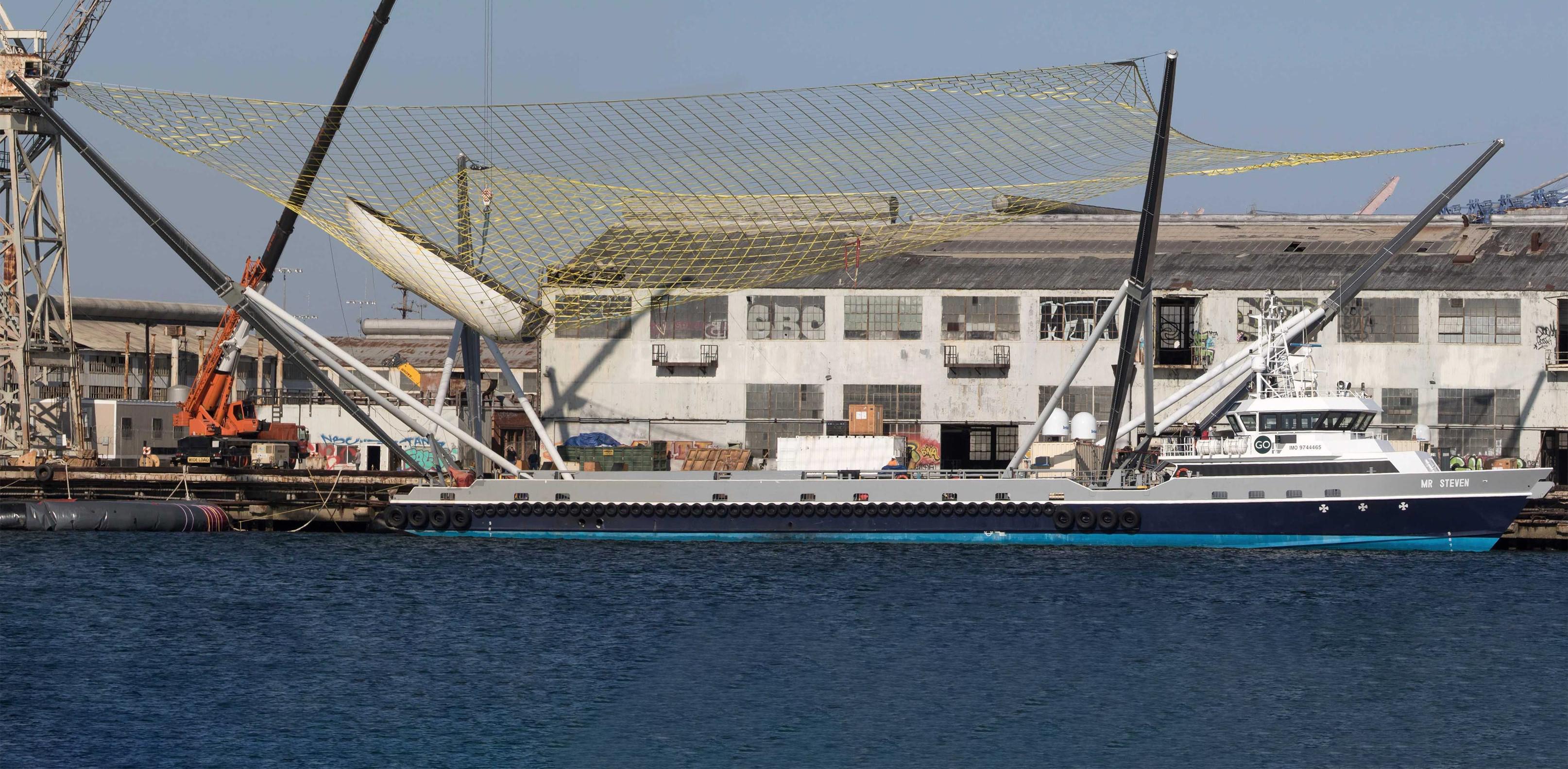

News
SpaceX attempts second Falcon fairing drop test with a helicopter and Mr. Steven
Following a few days of rest in port, SpaceX fairing recovery vessel Mr. Steven has continued a likely campaign of controlled drop tests with a second fairing recovery attempt, using a helicopter, spotter plane, and support vessel to pick up a Falcon fairing and drop it, theoretically allowing it to paraglide into Mr. Steven’s net.
While it’s nearly impossible to determine what happened without line-of-sight visual confirmation or an official announcement from SpaceX, it appears that Mr. Steven kicked off real catch attempts on October 11th, evidenced by his close interaction with a Blackhawk helicopter over the course of an hour or so. Another similar attempt occurred today, October 17th, and culminated with Mr. Steven returning once more to Port of San Pedro with the same test-focused fairing half on board, albeit not resting in his retracted net.
- SpaceX’s dedicated test fairing seen at Berth 240 on Oct. 15, a few days after its first apparent drop test. (Pauline Acalin)
- Mr. Steven and a recent arrival, barge PTS 185. The fairing cradle on deck suggests that this is probably the platform helicopters grab the fairing half off of. (Pauline Acalin)
After October 11th’s testing was completed, Mr. Steven returned to Port of San Pedro. On October 13th, he was docked at SpaceX’s Berth 240 facilities with net lowered and the test fairing half wrapped up on the docks, preventing confirmation of whether he carried the fairing half back from the testing region. A mid-sized barge also recently appeared at Berth 240 with a distinct Falcon fairing cradle onboard, perhaps explaining the presence of a tugboat (named Sir Richard) a few miles away from where this test campaign has been stationed – a barge would offer a flat, safe surface for a helicopter to hover over and pick up an unwieldy object such as a payload fairing.
Nearly identical to the October 11th test, Mr. Steven, tug Sir Richard, a Cessna chase plane, and a Blackhawk helicopter all converged around 100 miles southwest of Port of Los Angeles around 2pm PDT on October 17th prior to beginning recovery test operations. Mr. Steven and the tug Sir Richard – likely towing a barge being temporarily used to move a fairing half – arrived several hours beforehand at the test’s planned location.
- As of late, SpaceX technicians and engineers have going through quite a range of activities related to fairing recovery. (Pauline Acalin)
- A gif demonstrates just how taut Mr Steven’s net can be, thanks to mechanized rigging. 08/13/18 (Pauline Acalin)
- Mr. Steven returned to Port of San Pedro around 7pm on October 8th after a day spent at sea, apparently with a Falcon fairing half in tow. This is the second known time that a fairing has been in Mr. Steven’s net. (Pauline Acalin)
- One half of SpaceX’s Iridium-6/GRACE-FO just moments before touchdown on the Pacific Ocean. (SpaceX)
Eventually, a UH-60A Blackhawk helicopter – the same helicopter used on October 11 – lifted off from Catalina Island’s Avalon airport, taking about half an hour to reach Mr. Steven and Sir Richard. Once there, the helicopter very distinctly slowed down, eventually hovering just ~20 feet off the surface of the ocean, if not outright landing or perching on the aforementioned barge under the tug’s control. After several minutes in that state, the Blackhawk lifted off and immediately began climbing, reaching a peak of ~11,000 ft before (presumably) dropping its fairing payload and immediately diving down to follow its descent.
It’s undoubtedly an imperfect fit, but the helicopter appeared to follow Mr. Steven very closely over the course of the recovery attempt, sticking just a ~1500 ft or less above and a few hundred feet beside him as he raced to catch the falling fairing half. In fact, at least as a very rough approximation, the helicopter’s descent may be useful to judge the fairing’s behavior while gliding: taking ~14 minutes to travel descend 11,000ft and travel perhaps 2 miles (~10,500ft) horizontally, the fairing would dropped at a reasonable 13.1 feet per second (~4 m/s) once its parafoil opened and seemed to travel approximately one foot forward for every one foot down, also known as a 1:1 glide slope ratio.
And here's a little overview of the helicopter's path, mixed with a speed/altitude graph! Added some rough annotations to give an idea of what happened and in what time frame 😀 pic.twitter.com/e1rwZtkNHA
— Eric Ralph (@13ericralph31) October 18, 2018
Depending on wind conditions, parafoils can nominally be expected to achieve average glide slope ratios between 0 (high winds; falling like a literal rock) and 4 (no winds; almost as good as a bad airplane), meaning that Falcon fairings – judging from tangential data gathered from the helicopter following its descent – fly much like a parafoil, which is to say not great but better than a brick. The trick with parafoil control – which includes tweaking angles of attack and glide slope – lies more in the art of trading forward velocity for vertical velocity (or vice versa) at key moments. Assuming their control mechanisms have enough authority, paragliding fairings could ‘flare’ as they near Mr. Steven’s net, essentially angling upwards to briefly hover before dropping quickly, maybe giving the boat enough time to swoop in and place its net just beneath it.
In this way, a parafoil’s flexible, inflated wing (airfoil, to be precise) can allow it to maneuver quite a lot like a bird, at least more so than most other methods of flying humans have access to. Time will tell if SpaceX is having any luck perfecting the guidance and recovery of Falcon fairings, particularly with this campaign of under-the-radar drop tests. Even if Mr. Steven returns with a fairing half resting in his net, it will be more than a little ambiguous if it was placed there or he caught it, and any certainty will rely on official confirmation from SpaceX itself.
For prompt updates, on-the-ground perspectives, and unique glimpses of SpaceX’s rocket recovery fleet check out our brand new LaunchPad and LandingZone newsletters!
Elon Musk
Why Tesla’s Q3 could be one of its biggest quarters in history
Tesla could stand to benefit from the removal of the $7,500 EV tax credit at the end of Q3.

Tesla has gotten off to a slow start in 2025, as the first half of the year has not been one to remember from a delivery perspective.
However, Q3 could end up being one of the best the company has had in history, with the United States potentially being a major contributor to what might reverse a slow start to the year.
Earlier today, the United States’ House of Representatives officially passed President Trump’s “Big Beautiful Bill,” after it made its way through the Senate earlier this week. The bill will head to President Trump, as he looks to sign it before his July 4 deadline.
The Bill will effectively bring closure to the $7,500 EV tax credit, which will end on September 30, 2025. This means, over the next three months in the United States, those who are looking to buy an EV will have their last chance to take advantage of the credit. EVs will then be, for most people, $7,500 more expensive, in essence.
The tax credit is available to any single filer who makes under $150,000 per year, $225,000 a year to a head of household, and $300,000 to couples filing jointly.
Ending the tax credit was expected with the Trump administration, as his policies have leaned significantly toward reliance on fossil fuels, ending what he calls an “EV mandate.” He has used this phrase several times in disagreements with Tesla CEO Elon Musk.
Nevertheless, those who have been on the fence about buying a Tesla, or any EV, for that matter, will have some decisions to make in the next three months. While all companies will stand to benefit from this time crunch, Tesla could be the true winner because of its sheer volume.
If things are done correctly, meaning if Tesla can also offer incentives like 0% APR, special pricing on leasing or financing, or other advantages (like free Red, White, and Blue for a short period of time in celebration of Independence Day), it could see some real volume in sales this quarter.
You can now buy a Tesla in Red, White, and Blue for free until July 14 https://t.co/iAwhaRFOH0
— TESLARATI (@Teslarati) July 3, 2025
Tesla is just a shade under 721,000 deliveries for the year, so it’s on pace for roughly 1.4 million for 2025. This would be a decrease from the 1.8 million cars it delivered in each of the last two years. Traditionally, the second half of the year has produced Tesla’s strongest quarters. Its top three quarters in terms of deliveries are Q4 2024 with 495,570 vehicles, Q4 2023 with 484,507 vehicles, and Q3 2024 with 462,890 vehicles.
Elon Musk
Tesla Full Self-Driving testing continues European expansion: here’s where
Tesla has launched Full Self-Driving testing in a fifth European country ahead of its launch.

Tesla Full Self-Driving is being tested in several countries across Europe as the company prepares to launch its driver assistance suite on the continent.
The company is still working through the regulatory hurdles with the European Union. They are plentiful and difficult to navigate, but Tesla is still making progress as its testing of FSD continues to expand.
Today, it officially began testing in a new country, as more regions open their doors to Tesla. Many owners and potential customers in Europe are awaiting its launch.
On Thursday, Tesla officially confirmed that Full Self-Driving testing is underway in Spain, as the company shared an extensive video of a trip through the streets of Madrid:
Como pez en el agua …
FSD Supervised testing in Madrid, Spain
Pending regulatory approval pic.twitter.com/txTgoWseuA
— Tesla Europe & Middle East (@teslaeurope) July 3, 2025
The launch of Full Self-Driving testing in Spain marks the fifth country in which Tesla has started assessing the suite’s performance in the European market.
Across the past several months, Tesla has been expanding the scope of countries where Full Self-Driving is being tested. It has already made it to Italy, France, the Netherlands, and Germany previously.
Tesla has already filed applications to have Full Self-Driving (Supervised) launched across the European Union, but CEO Elon Musk has indicated that this particular step has been the delay in the official launch of the suite thus far.
In mid-June, Musk revealed the frustrations Tesla has felt during its efforts to launch its Full Self-Driving (Supervised) suite in Europe, stating that the holdup can be attributed to authorities in various countries, as well as the EU as a whole:
Tesla Full Self-Driving’s European launch frustrations revealed by Elon Musk
“Waiting for Dutch authorities and then the EU to approve. Very frustrating and hurts the safety of people in Europe, as driving with advanced Autopilot on results in four times fewer injuries! Please ask your governing authorities to accelerate making Tesla safer in Europe.”
Waiting for Dutch authorities and then the EU to approve.
Very frustrating and hurts the safety of people in Europe, as driving with advanced Autopilot on results in four times fewer injuries!
Please ask your governing authorities to accelerate making Tesla safer in Europe. https://t.co/QIYCXhhaQp
— Elon Musk (@elonmusk) June 11, 2025
Tesla said last year that it planned to launch Full Self-Driving in Europe in 2025.
Elon Musk
xAI’s Memphis data center receives air permit despite community criticism
xAI welcomed the development in a post on its official xAI Memphis account on X.

Elon Musk’s artificial intelligence startup xAI has secured an air permit from Memphis health officials for its data center project, despite critics’ opposition and pending legal action. The Shelby County Health Department approved the permit this week, allowing xAI to operate 15 mobile gas turbines at its facility.
Air permit granted
The air permit comes after months of protests from Memphis residents and environmental justice advocates, who alleged that xAI violated the Clean Air Act by operating gas turbines without prior approval, as per a report from WIRED.
The Southern Environmental Law Center (SELC) and the NAACP has claimed that xAI installed dozens of gas turbines at its new data campus without acquiring the mandatory Prevention of Significant Deterioration (PSD) permit required for large-scale emission sources.
Local officials previously stated the turbines were considered “temporary” and thus not subject to stricter permitting. xAI applied for an air permit in January 2025, and in June, Memphis Mayor Paul Young acknowledged that the company was operating 21 turbines. SELC, however, has claimed that aerial footage shows the number may be as high as 35.
Critics are not giving up
Civil rights groups have stated that they intend to move forward with legal action. “xAI’s decision to install and operate dozens of polluting gas turbines without any permits or public oversight is a clear violation of the Clean Air Act,” said Patrick Anderson, senior attorney at SELC.
“Over the last year, these turbines have pumped out pollution that threatens the health of Memphis families. This notice paves the way for a lawsuit that can hold xAI accountable for its unlawful refusal to get permits for its gas turbines,” he added.
Sharon Wilson, a certified optical gas imaging thermographer, also described the emissions cloud in Memphis as notable. “I expected to see the typical power plant type of pollution that I see. What I saw was way worse than what I expected,” she said.
-

 Elon Musk3 days ago
Elon Musk3 days agoTesla investors will be shocked by Jim Cramer’s latest assessment
-

 News1 week ago
News1 week agoTesla Robotaxi’s biggest challenge seems to be this one thing
-

 News2 weeks ago
News2 weeks agoTexas lawmakers urge Tesla to delay Austin robotaxi launch to September
-

 Elon Musk2 weeks ago
Elon Musk2 weeks agoFirst Look at Tesla’s Robotaxi App: features, design, and more
-

 Elon Musk2 weeks ago
Elon Musk2 weeks agoxAI’s Grok 3 partners with Oracle Cloud for corporate AI innovation
-

 News2 weeks ago
News2 weeks agoSpaceX and Elon Musk share insights on Starship Ship 36’s RUD
-

 News2 weeks ago
News2 weeks agoWatch Tesla’s first driverless public Robotaxi rides in Texas
-

 News2 weeks ago
News2 weeks agoTesla has started rolling out initial round of Robotaxi invites

